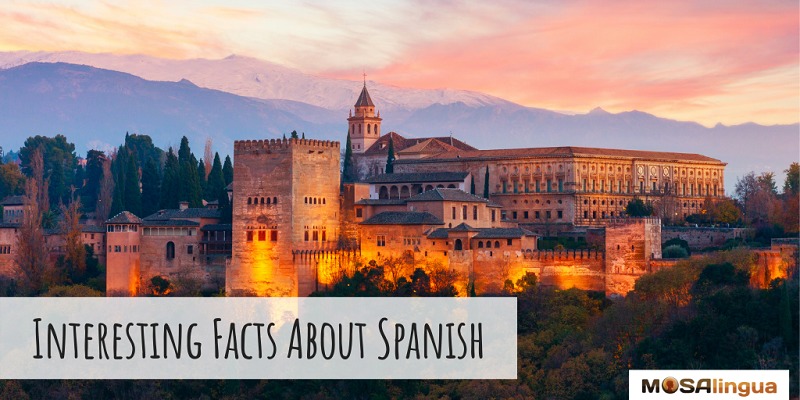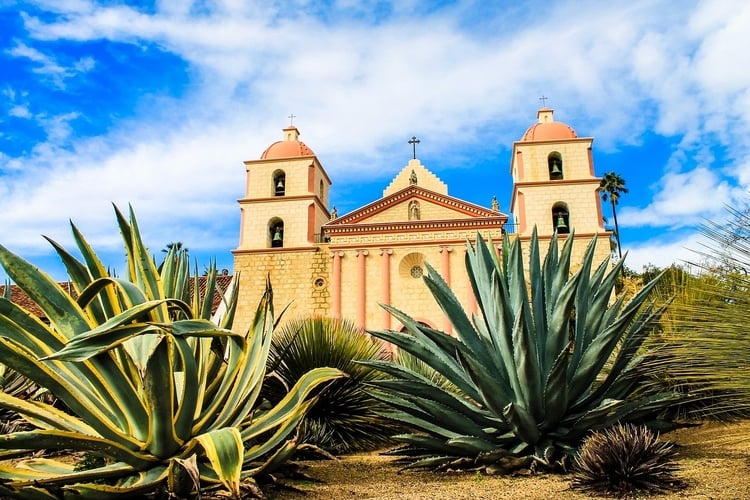The Spanish language is rich and multifaceted. Of course it’s useful to know the most common Spanish expressions, but it’s also worthwhile to learn a few things about the language itself. Not to mention, it’s interesting stuff! Here’s a short list of 15 interesting and fun facts about the Spanish language. A few of them even surprised me! (Be sure you remember #11—it’ll save you from more than a few embarrassing situations!)

If you’d prefer to listen, head over to our MosaLingua Language Lab podcast:
Listen to “# 43 – 15 Things You Didn’t Know About the Spanish Language” on Spreaker.
What’s inside…
15 Fun Facts About Spanish to Break Out at Your Next Dinner Party!
Like all languages, Castilian (or “Spanish”) has all kinds of little hidden gems for its learners to discover. Some are fun, while others are traps that non-native speakers have to watch out for. So, if you’re learning this beautiful language, if you speak it already, or if you’re just curious, keep reading to learn 15 fun facts about Spanish that you might not have known! ¿Vamos?
There are two ways of saying “I love you” in Spanish: “Te amo” and “Te quiero.” 😍 The first one is said between lovers or closely related family members and is more profound. The second one is typically not so romantic and more friendly.
Speaking of romance, where do you think Spanish ranks in our (very scientific) study of the sexiest accents? Take a look at the surprising tie for 1st place.
Did you know that there’s an extra letter in the Spanish alphabet and that it’s the only one of Spanish origin?
If you still haven’t guessed… it’s the “ñ.” It was first used as a kind of shortcut to write words from Latin with double “n,” such as the word “annus.” (In Spanish, “año,” with the letter “ñ.”) The tilde was shorthand for the second “n,” written over the first.
Eventually, in the 13th century, the Spanish King Alfonso el Sabio (Alfonso the Wise) approved the use of this symbol to write the sound as part of his Orthographic Reform of the Castilian language.
To learn how to pronounce this letter and the rest of the Spanish alphabet, here’s an article we recommend.
You might have heard people talking about a mysterious language called “Castilian.” But it’s less mysterious than you think. In reality, “Castilian” is just another name for Spanish! Now you know!
Why is Spanish also called Castilian? Well, the answer to this is very simple: the Spanish language emerged from Latin, but it happened in Spain, in a region called Castilla (we call it Castile in English), a large area that comprises more than one-quarter of the Spanish peninsula. Then, the name “Castilla” gave origin to the word “Castellano” and it later expanded to other countries.
Santa Iglesia Basílica Catedral Metropolitana de Santa María de Burgos, which is located in Castilla y León, formerly part of the Castilla region of Spain.
You might think that the roots of Spanish are purely Latin, but did you know that Arabic is the second-largest contributor to the Spanish language? The reason behind this fact is historical. Let me tell you a little story.
Once upon a time, there were some Arabians who decided to conquer their neighbors, who happened to be the Spanish. Once they reached the Iberian Peninsula, they implemented their language and culture, which then got mixed up with Spanish. Eventually, the Arabs were expelled from Spain. But the Spanish language retained roughly 8,000 words in Arabic. So, many words you might already know in Spanish actually come from Arabic. For instance:
- la almendra (almond)
- la almohada (pillow)
- or la alfombra (carpet)
Can you feel the Arabic sounds to these words? In Spain, there are also many places, regions, and historic sites named by the Arabians, such as “La Alhambra.” Or “Andalucia,” a Spanish community derived from the word “Al Andalus,” which is the Arabic name for Muslim Iberia. And the city and province “Guadalajara,” which comes from the Arabic word “Wādī al-Ḥijārah,” meaning river or canyon of stones.
Head over to this article to learn more Arabic vocabulary.
Start improving your Spanish today

Good news: we can help!
More good news: you can get started for free! With your free trial, you can test drive the most effective method for learning Spanish for the next 15 days!
Vocabulary flashcards, videos with subtitles, audiobooks, articles adapted to your level – with MosaLingua Premium (Web & Mobile), you’ll have access to all this and more. Get started right now. It’s free—and risk-free—to try!
More recently, in the 20th century, Spanish has adopted many English words into everyday vocabulary. For example:
- fútbol (football)
- suéter (sweater)
- pulover (pullover)
- overol (overall)
Even nowadays, Castilian is constantly incorporating new words from English. This is especially common with modern technology-related verbs, which are created by just adding the suffix -ear at the end of the word.
Try to guess what the following Spanish words mean, and then reveal the answer by highlighting the black box next to each word with your mouse! It might help to try and say them out loud…
- tuitear → to tweet
- escanear → to scan
This is one reason why Spanish isn’t that hard for native English speakers to learn.
Spanish grammar rules were first published in the year 1492. 1492—that year rings a bell! Oh, right! It’s the same year Columbus came to America. That’s an easy one to remember!
Need a hand learning Spanish grammar? We wrote up some mini Spanish grammar “cheat sheets” to help you with the most common topics:
➡️ Spanish Grammar Guide: Learn Spanish Grammar with Our Mini Lesson Cheat Sheets
You might already know that exclamations and questions in Spanish need to begin with an “opening” punctuation. These inverted exclamation and question marks only exist in the Spanish language. Personally, I find this one very handy as it helps you grasp the correct intonation right from the beginning of a sentence when you read out loud.
However, it’s a real nuisance when you’re typing in Spanish with a non-Spanish keyboard! And Spanish is the 3rd most used language on the Internet, so a Spanish keyboard would be a useful tool for about one-third of Internet users.
💡 MosaTip: If you don’t have a Spanish keyboard, learn how to change your keyboard settings to make it easier to type in Spanish.
If you’re translating from English to Spanish, your text is likely to end up 15-25% longer. The reason for this is that Spanish is more poetic, expressive, and detailed than English. We have to use more words to describe something that could be summed up in just one word in English.
An example? When talking about the direction of the hands of the clock, we would just say “clockwise” in English. But, in Spanish there is no such word, so we would have to say: “en el sentido de las agujas del reloj” (literally, “in the direction of the hands on a clock”)!
On the other hand, words are not necessarily longer than in other languages. Aside from the longest word in Spanish, which has 31 letters: esternocleidooccipitomastoideos. That’s a long word for a short muscle! Yes, it’s the name of a small muscle in your neck. It makes you wonder if Spanish speakers actually go to their doctor and pronounce this word… I would just say “Doctor, me duele aqui” (“I feel pain here”)!
By the way, English learners, please be careful with the next one, to avoid seriously embarrassing situations. English and Spanish share plenty of similarly-written words that don’t always mean the same things. We call these “false friends.” Some examples? “Embarazada” means “pregnant” in English, and not “embarrassed.”
I remember once a British friend of mine speaking in Spanish said to me, “Oh estoy embarazada y es por culpa de tu hermano.” In English: “I am pregnant, and it’s your brother’s fault.” 😳 I know… false friends can really put you into odd situations!
Other Spanish false friends are:
- “constipado” means “to have the flu” (not “to be constipated”)
- “gracioso” means “funny” (not “gracious”)
- and the list goes on!
According to some predictions, the USA could be the country with the largest Spanish-speaking population by the year 2050, with 132.8 million speakers! (As of 2021, next-door neighbor Mexico holds that title, and the U.S. comes in 5th in terms of native speakers.)
Many people think that English is this country’s official language, but that’s not true. There is no “official” language at the federal level, though 31 of the 50 states have made it an official language.
🗣 Shout out: How many Spanish-speaking countries can you name? List as many as possible in the comments!
Aside from the language people speak, Hispanic influence is very visible in some parts of the United States, including in food and architecture, like this building in Santa Barbara, California.
The letters “b” and “v” sound the same in Standard Modern Spanish. The “v” between vowel sounds is pronounced like a soft b, and the lips don’t even touch. “ViVa.” This sound doesn’t exist in English!
💡 MosaTip: If you need some help with your accent, check out our comprehensive Spanish pronunciation guide (+ free PDF).
Genders can be somewhat confusing in Spanish. Many nouns are spelled and pronounced the same but change meaning based on the article used, depending on if it’s feminine or masculine. For example,
- “el cometa” (comet ☄️) and “la cometa” (kite 🪁);
- “un cura” (a priest ⛪️) and “una cura” (a cure or medical treatment 💉);
- “un pendiente” (an earring 💎) and “una pendiente” (a slope 🏔).
And then, we have the word “mar” (sea) which can be used with either a feminine or a masculine article and wouldn’t suffer a change in its meaning.
Another good example is the word “la persona,” which, if taken literally, is feminine, but it can be used to refer to a man or a woman.
Compared to English, Spanish has a relatively free word order, and variations of the Subject-Verb-Object construction occur much more in the Spanish language. For example, you can write the sentence “David wrote the book,” (Subject – Verb – Object) as:
- “David escribió el libro”
- “El libro, escribió David” (to emphasize that he wrote the book and not something else)
- “¿Escribió David el libro?”
- And even “El libro, David escribió” (for more literary effect).
Be sure to comment on your favorite tidbit in the comments below. And feel free to share your own fun facts about Spanish culture and language, or interesting/funny/embarrassing experiences from learning Spanish!
Video: 15 Fun Facts About the Spanish Language
You can also hear about all these fun Spanish language facts from Lisa-Joy in the video below. It’s in English (with a few words in Spanish), but you can turn on subtitles in other languages by clicking on the “Settings” gear. You can also change the playback speed if you’d like. If you watch it directly on YouTube, be sure to browse our channel while you’re there. You’ll find tons more free language content and lessons!
Join our YouTube community for free today!
Take It Further
If you enjoyed this article, we think you might also enjoy reading about:


![MosaLingua Learning Languages During Sleep Study [VIDEO]](https://www.mosalingua.com/en/files/2016/09/1-768x384-2-300x150.jpg)



El libro escribió David doesn’t make sense in Spanish. You will need to add LO : El libro LO escribió David.
Also El libro David escribió won’t work. You will have to change the conjugation: El libro FUE escriTO POR David
Hi Verónica,
We’ve had a look at this article, and have changed it by adding a comma.
El libro, escribió David (emphasis on the coma) is something you would say to emphasize that he wrote the book and not something else.
Thanks for your help and enjoy the upcoming weekend!
Samuel W